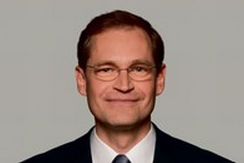San Antonio
Estados Unidos
Senator for the Urban Development and the Environment of Berlin, Germany (July 2013)
Mr. Michael Müller

1) The city of Berlin was registered on the World Heritage City List three times: in 1990, 1999 and 2008. What has been the impact of these nominations for your city?
Berlin is considered an international metropolis. The three different sites registered on the World Heritage List underscore the German capital’s worldwide reputation as a historical cultural center and as one of the birthplaces of modern architecture. The dramatic rise in visitor numbers since the fall of the Berlin Wall and German reunification is thanks in part to attractions like the World Heritage sites. And as a World Heritage city, Berlin has another “soft” factor that helps to attract companies looking for a new location, such as those in the cultural and creative industries.
2) In your opinion, what is the vital role of a mayor when a city has been inscribed on UNESCO’s World Heritage List?
As Berlin’s senator for urban development, which makes me responsible for historical preservation issues, and one of its mayors, I see myself as an ambassador and occasionally a lobbyist for UNESCO’s World Heritage concerns in my own city. At the same time, I am able to actively utilize and promote the preservation and inclusion of historical monuments and World Heritage sites in Berlin’s economic and urban development.
3) Concretely, what have been your actions toward the protection and enhancement of your heritage?
My predecessors in office and I have been able to persuade Berlin’s senator for finance to contribute state funds to the federal government’s investment program for UNESCO World Heritage sites in Germany, in order to maintain Berlin’s World Heritage housing estates of the 1920s and their affordable housing or to modernize the infrastructure on Museum Island in keeping with its status as a historical monument. The high volume of private investment stimulated by these projects benefits not only the monuments in question, but also the common good, in addition to protecting jobs. In the summer of 2012, we also helped two important World Heritage initiatives submit a successful application to be included on Germany’s Tentative List: the Jewish Cemetery in Weißensee and the postwar architecture on Karl-Marx-Allee and in the Hansaviertel.
4) Do you hold special events to enhance the heritage in your city?
Berlin sees itself not only as a UNESCO World Heritage city, but as a many-faceted and sometimes controversial monument location known around the world. Almost no other city offers a European Heritage Days event program as extensive as ours each year in September. The registered World Heritage sites and the candidates currently being discussed in the city of course play a key role here. Germany’s UNESCO World Heritage Day in June is another highlight. For 2013, for instance, we have invited conservators and representatives of the World Heritage city Tel Aviv in Israel to come to Berlin for an exchange of ideas in a public event on common ground in World Heritage preservation and on possibilities for future cooperation.
5) Berlin is the home of renowned industries, research institutes, IT industries, pharmaceuticals, biomedical and biotechnology industries… it is a touristic place and popular site for the movie industries. How would you describe the relationship between Berlin and innovation? How can we feel it in your city? How can heritage and innovation be mixed?
Heritage and innovation have long been intertwined in Berlin. A hundred years ago, Berlin was the largest industrial city on the continent. Many former industrial and technological monuments have taken on a new function since 1990 as homes to “new economy” companies or start-ups. Once abandoned, these locations have regained their reputation as attractive, lucrative places to do business. Many scientific and academic institutions have also benefited from a move into historical building complexes that had lost their original function. Our world-famous Tempelhof Airport, near the heart of the city, was closed in 2010, and we are planning to give it a vibrant second life that preserves its historic character. The fashion trade shows Berlin Fashion Week and Bread & Butter might be considered stopovers on the journey into the future of this unique historical monument.
6) In your opinion, what makes Berlin such a special place?
Berlin is not only one of UNESCO’s most important World Heritage cities, but – as a UNESCO City of Design – has long since taken its place in the global network of creative capitals in Europe. Today Berlin can call itself a “place to be,” with its rich cultural legacy from the past and a future of enormous potential as a metropolis open to the world.
Noticias
Juntos hacia el Nuevo Proyecto Urbano
Asistencia y cooperación técnica
Jóvenes y ciudadanos
Comunicación


